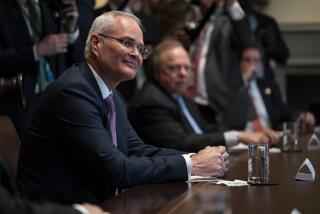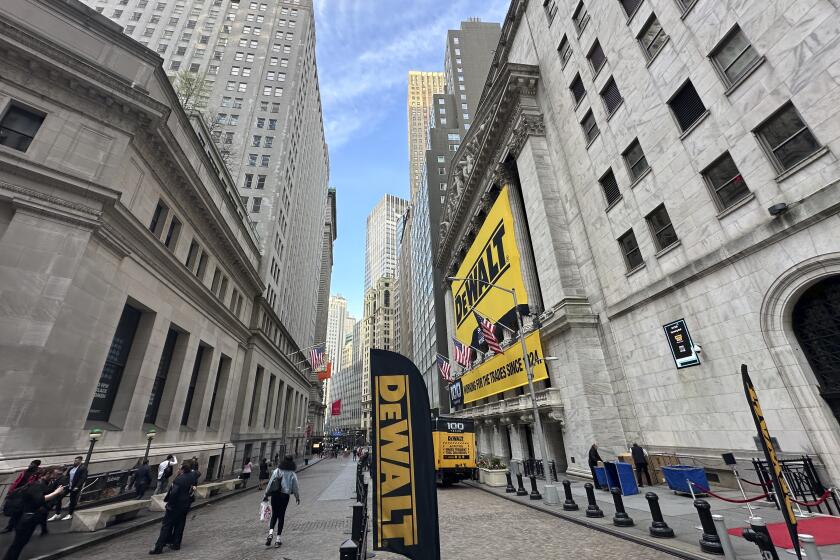Inflation fears not registering
Wall Street is counting on a Federal Reserve interest rate cut on Halloween, and policymakers are likely to have a hard time figuring why they should disappoint the markets.
The bogeymen that were supposed to frighten the Fed into holding the line on rates don’t seem very scary to the central bank or to a lot of investors these days.
Oil at a record high, gold at a 27-year high, the dollar at new lows -- in another time these might have fanned inflation worries and given the Fed pause before easing credit further in a still-growing economy.
But neither the bond market nor the stock market is showing anxiety about inflation. And that gives the Fed a green light to drop its key short-term rate again.
At the end of their two-day meeting Wednesday, policymakers are expected to cut their rate from 4.75% to 4.50%, the lowest since Chairman Ben S. Bernanke took the helm of the Fed on Feb. 1, 2006.
That would follow the half-point cut the central bank made on Sept. 18, when Bernanke and peers sought to calm financial markets after the wild swings of late summer stemming from the global credit crunch.
The credit crunch, of course, was rooted in surging U.S. mortgage defaults and fears that the housing market’s slide would drag down the economy overall. Suddenly in August, some lenders and investors who had been extending credit to even the diciest borrowers just nine months earlier became unwilling to lend to anyone other than the U.S. Treasury.
The Fed, as usual in times of market panic, rode in. The rate cut on Sept. 18 was intended “to help forestall some of the adverse effects on the broader economy that might otherwise arise from the disruptions in financial markets,” the Fed said that day.
When the government on Wednesday morning issues its first estimate of third-quarter economic growth, it may look like the “adverse effects” haven’t amounted to much.
Peter Kretzmer, economist at Banc of America Securities in New York, figures the economy grew at a real annualized rate of 3.5% in the quarter ended Sept. 30, as consumers kept spending and exports boomed (thanks to the weak dollar).
As for the credit crunch, some investors voted with their dollars Friday that the worst might have passed for some of the financial companies that have been hit hardest by losses on mortgages and mortgage-backed bonds: Countrywide Financial Corp. helped spark a strong rally in financial stocks after it reported a $1.2-billion third-quarter loss but also said it expected to be back in the black this quarter and in 2008.
But if the economy continues to expand and the credit crunch is easing, why do we need lower interest rates?
Insurance, Kretzmer and other analysts say. They contend the risks still are high that the economy could slide into recession without help from the Fed.
Growth may slow to just 1.5% in the current quarter, Kretzmer says, as the effects of housing’s deep slump become more pronounced, particularly on consumers’ willingness or ability to spend.
On Friday, the University of Michigan’s national consumer confidence index slid to its lowest level since May 2006, suggesting consumers’ faith in the economy was ebbing.
David Kelly, economist at Putnam Investments in Boston, said he worried that many corporate chiefs had been shaken by the credit market upheaval of recent months and could begin to pare back on capital spending and on hiring as a precaution -- raising the risk of recession.
Conventional wisdom is that executives want lower interest rates. Kelly, however, said he believed that additional Fed rate cuts might reinforce execs’ concerns about the economy (i.e., “Uh-oh, things are getting worse”), rather than boost their optimism about the outlook.
“What the Fed has to do is bolster confidence in the economy,” Kelly said. As usual, they’ll probably try to do that in their statement next week -- even as they order another rate cut.
As for stock investors, they don’t appear to be worried about recession, here or abroad.
The Dow Jones industrial average has risen in six of the last seven weeks and at 13,806.70 on Friday was a mere 2.5% below its record high reached Oct. 9.
Stock indexes hit new highs Friday in Hong Kong, Brazil and India, among other markets.
For the Fed, the more important barometer of investor sentiment may be long-term bond rates because those yields would be expected to provide early warning of investors’ concern that inflation could rise and eat away at fixed returns.
The 30-year Treasury bond yield rose for a few days after the Sept. 18 rate cut, suggesting that investors were voting against easier credit and the risk that it could stoke the economy and inflation pressures.
Yields have since drifted down again, however. And they have done so even in the face of some classic inflationary threats: a tumbling dollar (which can boost prices of imported goods) and a relentless climb in oil prices.
The surge in gold, now nearing $800 an ounce, also seems to underscore inflation risks because one historical role for the metal is as an inflation hedge.
But there’s a good reason the bond market and the Fed aren’t losing sleep over the old inflation bogeymen, says David Rosenberg, an economist at Merrill Lynch & Co.: Investors have been hearing the same warnings about rising commodity prices and the falling dollar for six years, he says -- and yet inflation, at least as the government measures it, has remained relatively tame.
Hear the same song over and over, and you start to not hear it at all. Investors can only hope that they aren’t tuning out just as the warnings actually begin to mean something.
--






